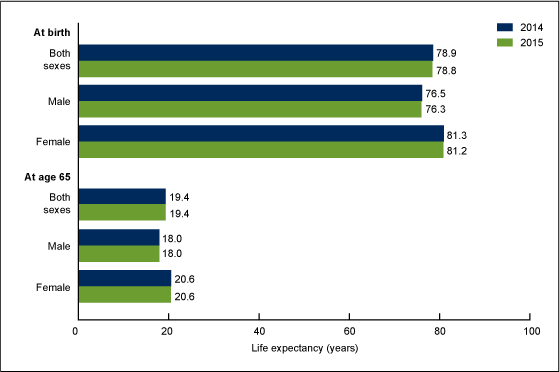Rising mortality from a variety of illnesses caused life expectancy for Americans to drop in 2015 for the first in more than two decades, according to a National Center For Health Statistics study released Thursday.
The drop of 0.1 percent was small ― life expectancy at birth was 78.8 years in 2015, compared with 78.9 years in 2014. But it reverses a long trend, and the factors that led to it are worth looking at.
Diseases caused more deaths in 2015 than they did the year before. Age-adjusted death rates increased overall by 1.2 percent, from 724.6 deaths per 100,000 standard population in 2014 to 733.1 in 2015. Death rates went up for eight of the 10 leading causes of death, including heart disease, chronic lower respiratory diseases, unintentional injuries, stroke, Alzheimer’s disease, diabetes, kidney disease and suicide. The rate decreased for cancer, according to the study.
The drop in life expectancy is troubling, some experts said, because there had been an expectation that the measure would steadily go up in Western societies. The last U.S. decline was in 1993, according to the World Bank.
“That’s our idea of what it means to be in an advanced society,” Jarron Saint Onge, assistant professor at Kansas University’s Department of Sociology and Health Policy and Management, told The Huffington Post. “Especially as we have more capacity to control lifestyle diseases.”

Higher death rates are most prevalent, Saint Onge noted, in poorer communities. “It has to do with smoking, obesity, lack of quality diets and exercise, which are really responses to poverty,” he said.
Obesity, for example, is associated with diabetes, heart disease and stroke ― all of which caused more deaths last year, according to the Centers for Disease Control and Prevention.
“There’s still clearly a lot of work that needs to be done,” Saint Onge added. “A lot are things we can control.”
The death rate increased among non-Hispanic white males, non-Hispanic white females, and non-Hispanic black males, the study found.
The study’s authors said they were baffled by the results.
“This is unusual, and we don’t know what happened,” Jiaquan Xu, an epidemiologist and lead author of the study, told The Washington Post. “So many leading causes of death increased.”

Globally, life expectancy is 71.4, an increase of five years since 2000, according to the World Health Organization. Global life expectancy dropped in the 1990s due to AIDS in parts of Africa.